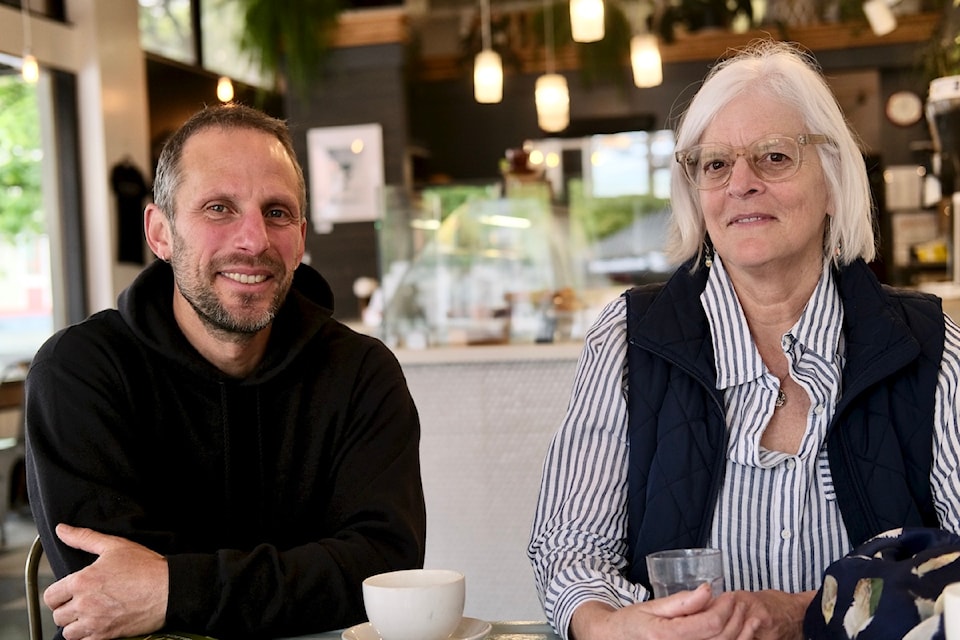David Moskowitz jokes that his main skill as a photographer is his willingness to carry camera equipment into places no one else wants to go.
"I found myself trekking across the Columbia Icefield in absolutely awful conditions, postholing up to my knees for miles in a whiteout across a rolling and endless sea of snow," the Washington-based photographer, biologist and wildlife tracker said, describing an expedition to photograph one of the wilderness areas of the Columbia River basin.
Eileen Delehanty Pearkes, co-author with Moskowitz of Big River: Resilience and Renewal in the Columbia Basin, published this year by Braided River Press, says Moskovitz's adventurous spirit was perfect for the task of portraying the variety of landscapes, ecosystems, species, people, and cultures in the basin.
"Nobody's going to do what David did," she told the Nelson Star. "Maybe there's another crazy person out there who is going drive off to all corners of the basin. But very few people are going to do his kind of adventure work."
The Columbia River watershed covers an area the size of France, extending from north of Revelstoke into Idaho and Oregon, and contains dozens of tributaries and ecosystems as well as hundreds of communities.
Moskowitz is the author of four books: Caribou Rainforest, Wildlife of the Pacific Northwest, Wolves in the Land of Salmon. and (as co-author) Peterson’s Field Guide to North American Bird Nests.
Pearkes' books A River Captured, The Geography of Memory, and The Heart of a River all explore the geography, history and landscapes of southeastern B.C.
Moskowitz said Big River is his most ambitious photographic storytelling project yet, because it is not centred on one particular species or environment, but on a broader and more complex landscape.
"Over the course of capturing photographs for this book," he writes in Big River, "I have found myself taking pictures of desert wildlife one day, dam operators navigating huge barges down the Snake River the next, and people fishing for salmon on a rainforest-shrouded tributary the next ... Two days after eating lunch on the banks of a river that begins in the arid mountains of central Idaho, I was trekking across ancient ice atop some of the highest peaks of Canada."
Moskowitz said he sees Big River as a series of stories, in photographs and in words, of different relationships to the river.
"What does the person who manages the locks on the dams on the (tributary) Snake River think about the river? And what does the rancher in rural Oregon think about the river? And what does an Indigenous fisherman think about it? All of that's in there. So by the time you may get to the end of this book, you're going to have a much broader cultural perspective on the meaning and value of the river."
Salmon
Reflecting her perennial interest in Indigenous life in the Columbia watershed, Pearkes opens Big River with a list of the language and cultural identities that have historically populated the basin: Chinookan/Chinook Wawa, Interior Salish, Kalupuyan/Molala, Ktunaxa/Kutenai, Sahaptian/ Ichishkín, and Shoshone/Uto-Aztecan.
She goes on to recount a detailed history – told in stories about culture, geography, languages, and industry – of the basin before and after the arrival of Europeans, and before and after dozens of dams were built on the Columbia system.
Those dams, built to provide flood control, hydro power and irrigation in the U.S., have also had unintended ecological and cultural consequences, including the destruction of the salmon runs.
"Dams interrupt a gift exchange between water and land," Pearkes writes, "one that had evolved over millions of years in the Columbia Basin — the salmon-to-ocean-to-land-and-back-again process. In doing so, they interrupt the often unseen movement of sediments from terrestrial sources, those that contribute vital structure and minerals to riverbeds and shorelines."
In Big River, Pearkes describes successful attempts by Indigenous groups to right this balance, not by insisting that the dams be removed but by finding ways to work around them.
'Seeking a common purpose'
She describes of an alliance between the Colville Confederated Tribes (in the U.S.) and the Okanagan Nation Alliance (in Canada) that has increased the average number of fish returning to Canada through the Columbia system tenfold since the early 2000s. They have done this through a mix of habitat restoration, restocking, hatcheries and removal of barriers.
The vision of a river system that can provide both irrigation and salmon runs, both flood control and ecological integrity, is central to the authors' message in Big River.
Moskowitz recounts his conversation with a dam employee who dismissed the idea of salmon restoration with the question: "Do you want bread or fish?" The worker was referring to a choice between a fishery on one hand and agricultural irrigation and related barge transport on the other.
"I think the idea that it's a zero-sum game, that you can either have fish or have irrigation and powered flood control, is just clearly false," Moskowitz said.
Moskowitz and Pearkes say the timing is right for change because the Columbia River Treaty between the U.S. and Canada is now being renegotiated. Perhaps a new treaty will have new priorities, shared by the two countries and the Indigenous inhabitants, that include healthy and fully functioning ecosystems.
"Three of the basin’s largest tributaries —the Columbia, Kootenai, and Pend Oreille," Pearkes writes, "cross the international boundary between the United States and Canada, braiding together the two countries, seeking a common purpose."
